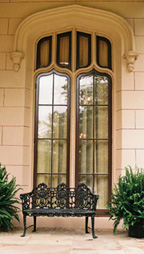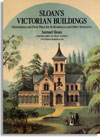 |

Construction
must have begun on Will Henry Coxe's Gothic mansion soon after he purchased
the Salem Road lot in November 1857, for young Emma Finley noted in her
diary an excursion to view the house in August of 1858.
Local historian John
M. Mickle (1860-1942) commented that the Coxe estate was the grandest
in Holly Springs. Originally covering fifteen acres, the grounds extended
eastward to Chesterman Street and down Chesterman half way to College
Avenue. A fine cast-iron fence with massive entrance gates ran for a
hundred yards across the Salem frontage. Manufactured by Wood & Perrot
of Boston, it is identical to one at the United States Military Academy
at West Point.
Much
landscaping was done, Mr. Mickle noted, almost wholly in the way
of trees and shrubs. Small cedars, kept properly timmed, formed
hedges for the drive. The architecture of the large stable/carriage
house (which he remembered) conformed with the Gothic style of
the house, as did the kitchen and servants quarters in the rear of the
house. The place had its own gas plant for lighting the mansion
itself and the other buildings, including the stable.
Inside the
mansion, the double parlors on the west had Carrara marble mantles and
the other downstairs rooms, slate mantles that were marbleized. The downstairs
hardware was silver. Among the most notable features
was the first bathroom in Holly Springs with running water (pumped by
hand). Mr. Mickle also recalled that a system of call bells
from all rooms was also arranged, with old-fashioned bell cords. A
hundred years later, traces of the bell system were still in evidence
on what had been the back outside wall of the mansion in the Dean family's
card room.
Two early images of the Coxe estate have been preserved. The first
is an oil painting showing the mansion, the stable/carriage house and
the servants house. The second is a twentieth century wood block
print that later owners in the Dean family commissioned Holly Springs
artist Netty Fant Thompson to make from a daguerreotype in the
possession of Coxe descendants. The two images complement each other
and confirm the original appearance of the mansion and its surroundings.
Extending
across almost the entire front facade was a flat-roofed structure of
porches with a central porte cochere. Supported by cast-iron columns
(very like the ones at the Bonner-Belk house, Cedarhurst, a house
undoubtedly designed by the same hand), the structure was topped by a
parapet of wooden tracery. The wood block print shows that the
west balcony too was of frame construction.
The stable/carriage
house (located behind the 1870s cottage at 395 E. Salem Avenue)
had a large arched opening echoing the arched windows and doors of the
mansion, above which was a large circular aperture like those in the
gables of the mansion. The roof line was outlined by the same tracery
as that of the mansion and capped by a similar finial. To
the west rear of the mansion was the servants house, with gables, narrow
Gothic windows, tracery, and finials matching those of the mansion. All
buildings were a salmon color.
The sophistication
of the design raises the question of the identity of the architect. The Coxes
may well have been drawn to the Gothic mode during their extensive travels
in the east, where Gothic mansions and cottages had become popular. The
Gothic style had been introduced in America by Andrew J. Davis in the
1830s and popularized by Andrew Jackson Downing's The
Architecture of County Houses, published in 1853.
Other books like The Model Architect (1852-3), by Philadelphian Samuel
Sloan, and Villas
and Cottages (1857)
by Calvert Vaux, Downing's partner and successor, also featured complete Gothic
house plans and sections on Gothic details. In the second Sloan volume,
the illustrations for the "Gothic Villa," design Forty-Fifth and
"A Gothic Front" bear a striking resemblance to the Coxe mansion.
The Sloan firm was active in the deep South in the 1850s. Samuel
Sloan of Sloan and Stewart of Philadelphia was design architect for the
Bryce Hospital in Tuscaloosa, begun in 1852. His partner John Stewart
was the construction architect, and Fletcher Sloan, Samuel s younger
half-brother, was sent to Tuscaloosa to be building superintendent. By
1857, the construction had bogged down, and Fletcher Sloan took on other
work as architect. He is credited with several Tuscaloosa houses
of the 1850s. The Sloan and Stewart partnership was dissolved in
1857. Stewart is credited with designing Robert Jemison s Tuscaloosa
house in 1860.
Two
Columbus, Mississippi, buildings the First Methodist Church (1861-68)
and the Topp mansion, Rosedale (ca. 1856) were based on designs
in Samuel Sloan s book. It is quite likely that Fletcher Sloan
was involved in these projects, as well as in the Coxe and Bonner mansions
in Holly Springs. In the 1860s, Fletcher Sloan settled first
in Memphis and later in Bolivar, Tennessee. His firm Willis, Sloan,
and Trigg were the architects for the courthouses in Bolivar (1868),
Holly Springs (1870), and Oxford (1872). Before it was restored,
the painting of the Coxe mansion at the time of its construction bore
the difficult to decipher signature of the artist, consisting of just
a few letters. I wonder now whether it was Sloan.
We
do know definitely the craftsmen employed in the construction of the mansion. Franz
Wilhelm Rittlemeyer, a Prussian carpenter, was brought to Holly Springs
to work on the Coxe house. Census records show that he had lived in Tennessee
(probably in Memphis) from 1853 though 1857.
On 30 Dec. 1857, he
purchased lots 21 and 22 in what was called the Frazier Subdivision on
what is now Van Dorn Avenue. He first built the cottage to the east of
the fine Italianate frame residence (now known as Hillside ) that
was long the Rittlemeyer home. The 1860s census shows that living
in the Rittlemeyer household were four other carpenters, three from Prussia
and one from Breman. Living next door was the Kentucky-born brick
mason John Long, whose descendants continued in his calling locally until
the middle of the last century. His grandson told the late Charles
N. Dean that John Long had been in charge of the brick work on the Coxe
mansion.
THE LEAN YEARS | REVIVAL | THE DEAN YEARS | RESTORATION | NOTES



